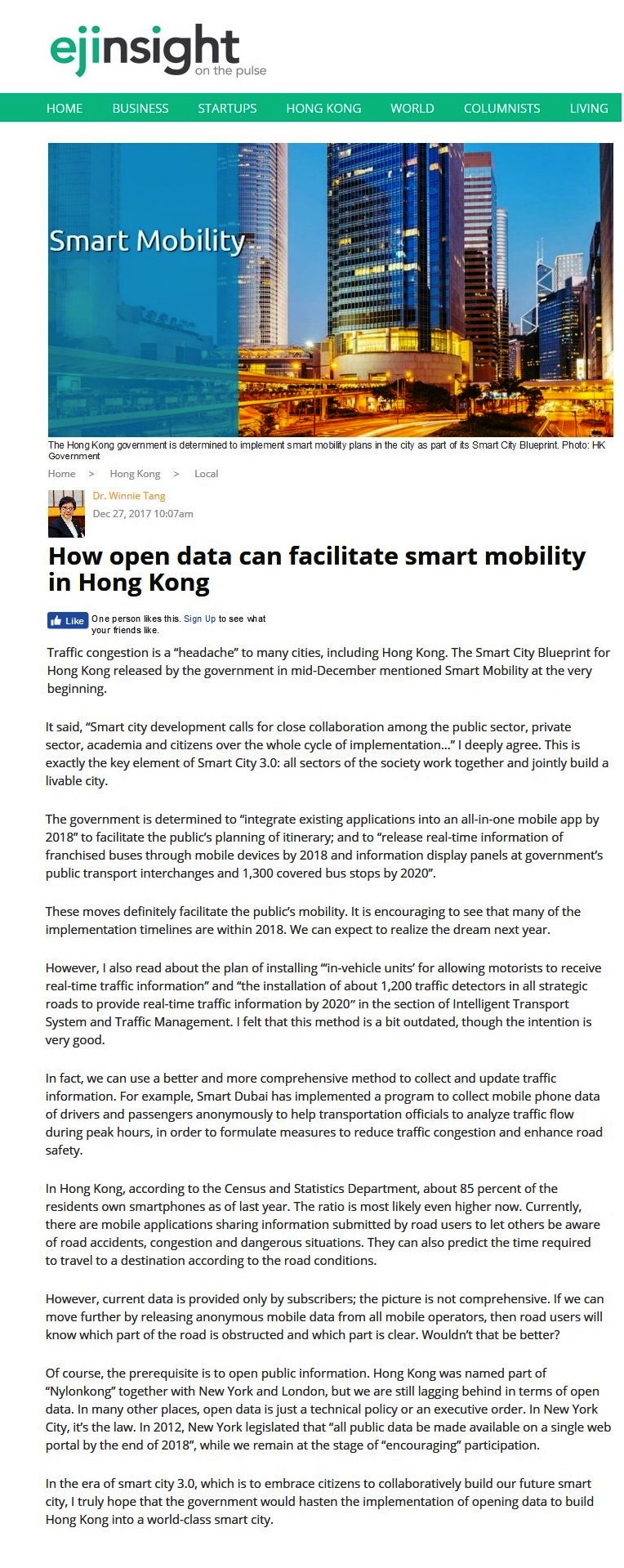網上版請按此

How open data can facilitate smart mobility in Hong Kong
Traffic congestion is a "headache" to many cities, including Hong Kong. The Smart City Blueprint for Hong Kong released by the government in mid-December mentioned Smart Mobility at the very beginning.
It said, "Smart city development calls for close collaboration among the public sector, private sector, academia and citizens over the whole cycle of implementation..." I deeply agree. This is exactly the key element of Smart City 3.0: all sectors of the society work together and jointly build a livable city.
The government is determined to "integrate existing applications into an all-in-one mobile app by 2018” to facilitate the public's planning of itinerary; and to "release real-time information of franchised buses through mobile devices by 2018 and information display panels at government's public transport interchanges and 1,300 covered bus stops by 2020".
These moves definitely facilitate the public's mobility. It is encouraging to see that many of the implementation timelines are within 2018. We can expect to realize the dream next year.
However, I also read about the plan of installing "'in-vehicle units' for allowing motorists to receive real-time traffic information" and "the installation of about 1,200 traffic detectors in all strategic roads to provide real-time traffic information by 2020" in the section of Intelligent Transport System and Traffic Management. I felt that this method is a bit outdated, though the intention is very good.
In fact, we can use a better and more comprehensive method to collect and update traffic information. For example, Smart Dubai has implemented a program to collect mobile phone data of drivers and passengers anonymously to help transportation officials to analyze traffic flow during peak hours, in order to formulate measures to reduce traffic congestion and enhance road safety.
In Hong Kong, according to the Census and Statistics Department, about 85 percent of the residents own smartphones as of last year. The ratio is most likely even higher now. Currently, there are mobile applications sharing information submitted by road users to let others be aware of road accidents, congestion and dangerous situations. They can also predict the time required to travel to a destination according to the road conditions.
However, current data is provided only by subscribers; the picture is not comprehensive. If we can move further by releasing anonymous mobile data from all mobile operators, then road users will know which part of the road is obstructed and which part is clear. Wouldn't that be better?
Of course, the prerequisite is to open public information. Hong Kong was named part of "Nylonkong" together with New York and London, but we are still lagging behind in terms of open data. In many other places, open data is just a technical policy or an executive order. In New York City, it's the law. In 2012, New York legislated that "all public data be made available on a single web portal by the end of 2018", while we remain at the stage of "encouraging" participation.
In the era of smart city 3.0, which is to embrace citizens to collaboratively build our future smart city, I truly hope that the government would hasten the implementation of opening data to build Hong Kong into a world-class smart city.
Dr. Winnie Tang
Honorary Professor, Department of Computer Science, The University of Hong Kong